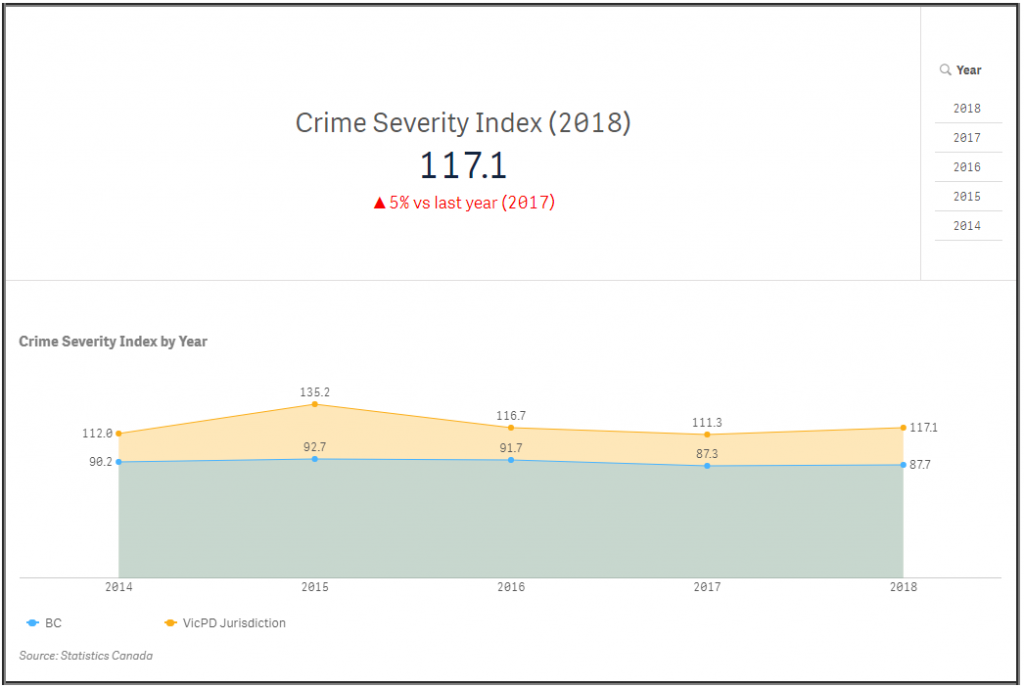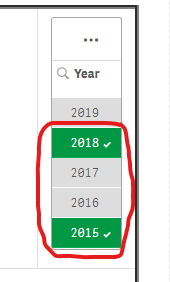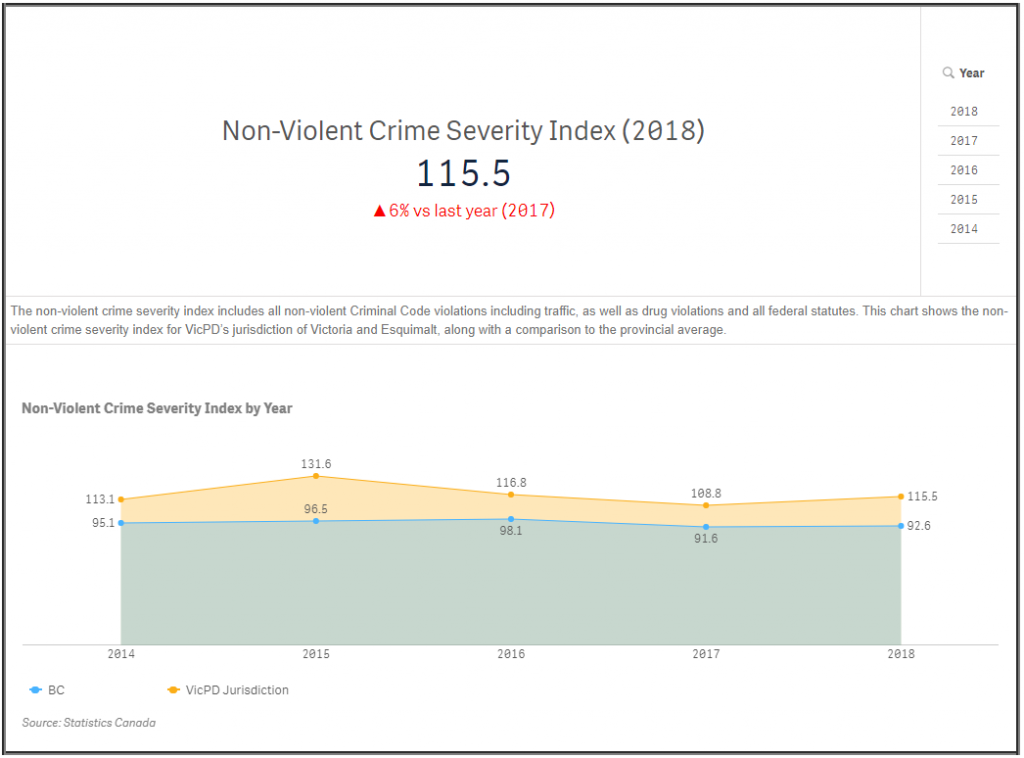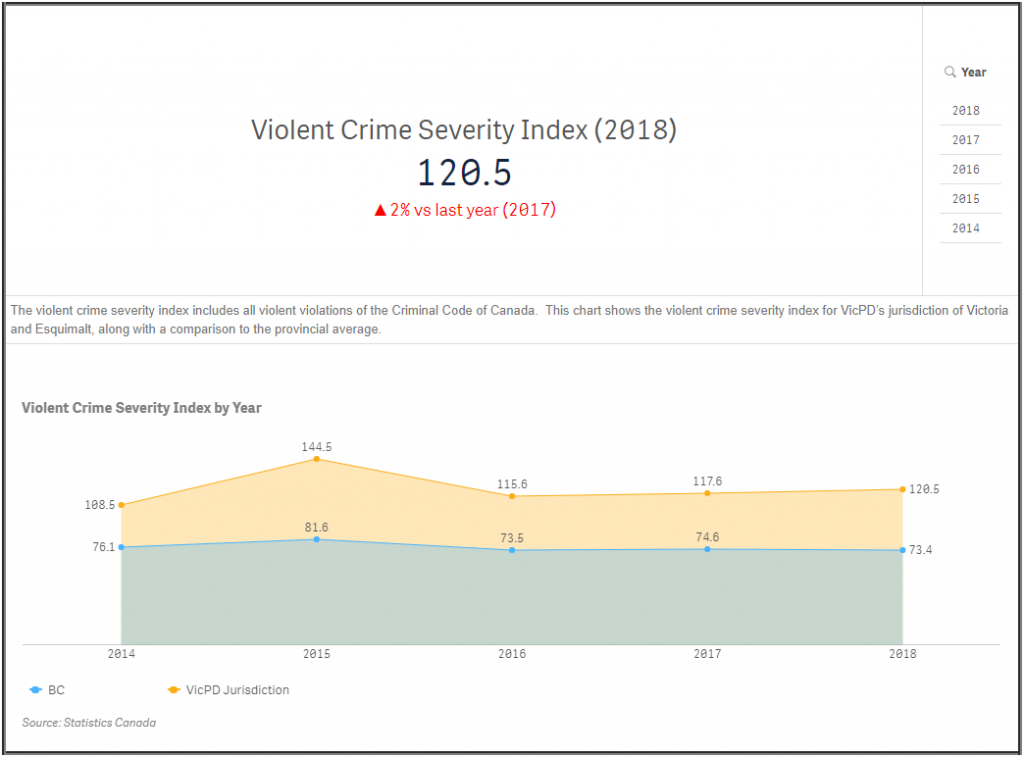Date: Thursday, October 8, 2020
Victoria, BC – This week, as part of our Open VicPD efforts to be as transparent and accountable as possible, we continue our deeper dive into our interactive VicPD Community Dashboard as we explore the Crime Severity Index.
The Crime Severity Index is one of fifteen measures on our Community Dashboard, which, along with our online quarterly reports, publications, and other information are part of Open VicPD, and are how we are telling the story of working towards our strategic vision of “A Safer Community Together.”
 Crime Severity Index – Community Dashboard
Crime Severity Index – Community Dashboard
The Crime Severity Index complements measures like Calls for Service and Crime Rate, in helping to determine both how busy the Department is and how serious crimes occurring in Victoria and Esquimalt are.
What is the Crime Severity Index?
Created by Stats Canada, the Crime Severity Index was designed to enable Canadians to track changes in the severity of police-reported crime from year to year. It does so by taking into account not only the change in volume of a particular crime, but also the relative seriousness of that crime in comparison to other crimes. It is a combination weighted measure of how many instances of an offence are reported to police, and how severe that offence is. Stats Canada goes into greater detail in their excellent, extensive explainer on the Crime Severity Index. We report our information to Stats Canada annually as part of the Uniform Crime Reporting Survey.
As it is an annual measure, the latest Crime Severity Index data is from 2019. The Crime Severity Index is currently reported as a combined measure for both Victoria and Esquimalt. We are anticipating that it will change to focus on each individual municipality in 2021. Our current display is the combined measure, and includes a benchmark against the B.C. Crime Severity Index measure.
Our Community Dashboard displays the Crime Severity Index in three different ways.

The first Crime Severity Index graph displayed is the full measure. This full measure includes both violent and non-violent crimes and their trends over the last five years. This measure also includes a comparison to the B.C. overall Crime Severity Index, which is a good benchmark to know whether we are above, below, or on par with the rest of the province. The combined Crime Severity Index for Victoria and Esquimalt tends to be higher than that of the rest of the province. As with similar graphs in the Community Dashboard, the lines show the year to year trend. Hovering over the point in time dots reveals the specific number of calls for service for each individual year.
The “Year” menu in the upper right hand corner allows you to select specific years.

The Crime Severity Index measures are also broken out into two additional subset graphs. The first subset graph displays non-violent crime severity. Non-violent offences too are weighted by the Stats Canada Crime Severity Index formula. Similar to the other graphs in this measure, this graph includes a benchmark comparison to the B.C. overall Crime Severity Index. These include all non-violent Criminal Code violations including traffic, as well as drug violations and all federal statutes.

The second subset graph displays violent crime severity. Violent offences are also independently weighted by the Stats Canada Crime Severity Index formula. Similar to the other graphs in this measure, this graph includes a benchmark comparison to the B.C. overall Crime Severity Index. These include all violent violations of the Criminal Code of Canada.

We Want to Hear From You!
As part of our goals to improve your understanding of how we work and what measures we’re using and why, we welcome your feedback. Please email us your questions and suggestions.
Up Next
Next week, we take a closer look at the Stats Canada-generated partner to Crime Severity Index; Crime Rates.
Each week we’re looking at one of our Open VicPD Community Dashboard measures in detail to help you understand what we’re measuring, why we’re measuring it and how we think it helps you track our progress towards achieving our goals.
Join us on Twitter, Facebook, Instagram and VicPD.ca to come along for a deeper dive into Open VicPD.
-30-
